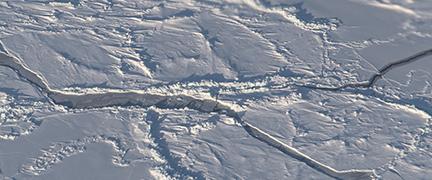
IMAGE: Banner image: Arctic sea ice, as seen from a 2019 Operation IceBridge flight.
view more
Credit: Credit: NASA/Jeremy Harbeck
With a small nudge to a satellite’s orbit, scientists will soon have simultaneous laser and radar measurements of ice, providing new insights into Earth’s frozen regions. On July 16, the European Space Agency (ESA) begins a series of precise maneuvers that will push the orbit of its radar-carrying CryoSat-2 satellite about half a mile higher – putting it in sync with NASA’s laser-carrying Ice, Cloud and land Elevation Satellite 2, or ICESat-2.
When the maneuvers are complete later this summer, the two satellites will pass over a swath of the Arctic within a few hours of each other. That synchronous stretch, of more than 2,000 miles (3,200 kilometers) every day or so, will be key for studying sea ice, which floats on the Arctic Ocean and is moved around with currents and winds. If the satellites take measurements at different times, the two could be measuring different floes of fast-moving ice. Syncing up the satellites provides scientists with two datasets for the same ice.
“Combining these two measurements from space will lead to a golden age,” said Tommaso Parrinello, CryoSat-2 mission manager with ESA. “It’s a small change for CryoSat-2, but will be a revolution for the science.”
Both CryoSat-2’s radar and ICESat-2’s laser instrument, called a lidar, measure height by sending out signals and timing how long they take to reflect off Earth’s surface and return to their respective satellites. But the different signals bounce off some surfaces differently – including snow-covered sea ice. Radars like Cryosat-2’s will penetrate through the snow layer and reflect off the ice below. Laser instruments like ICESat-2’s will reflect off the top of the snow layer. The difference between the two will give scientists the depth of the snow atop sea ice.
“If you have laser and radar together, it gives you this really exciting opportunity to measure the depth of the snow, which we’ve really never been able to do before from space,” said Rachel Tilling, a sea ice scientist at NASA’s Goddard Space Flight Center in Greenbelt, Maryland and the University of Maryland in College Park. “And with snow depth, we can get significantly more accurate measurements of sea ice thickness.”
With better measurements of snow depth and sea ice thickness, researchers can gain insights into the complex Arctic climate system. Sea ice might just be 10 feet thick or so, but it has an outsized effect on Earth’s climate, forming a kind of a protective blanket on the Arctic Ocean, Tilling said. The snow on top reflects radiation from the Sun, keeping the ice from melting and the ocean from warming. The ice itself acts as a barrier between the atmosphere and the ocean – removing it could alter circulation patterns that reach the more temperate parts of the globe. The new information could improve climate models, as well as lead to more accurate shipping navigation forecasts, she said.
The idea of aligning the two satellites has been floating around among the ice science community since CryoSat-2 launched in 2010, when ICESat-2 was still in the development stage, said Tom Neumann, ICESat-2 project scientist at NASA Goddard.
“This opens up new science possibilities that weren’t possible with either mission independently, especially for sea ice science,” Neumann said. “It’s a grassroots effort, promoted by the scientists and engineers asking if there was a way we can make this happen.”
The CryoSat-2 flight operations team took a look and after months of analyzing orbital dynamics came up with a plan. The European satellite orbits much higher and slower than the American one, so they couldn’t simply follow each other in tandem, said Ignacio Clerigo, CryoSat-2’s spacecraft operations manager. Instead, they realized they could raise the altitude of the spacecraft by just more than half a mile (900 meters), through a series of 15 precisely timed thruster burns, and then the two satellites would overlap every 19th orbit of CryoSat-2 and 20th orbit of ICESat-2. The overlaps are mostly over the Arctic; next Northern Hemisphere summer ESA might precisely alter the orbit again with another set of maneuvers to focus on the Antarctic during that region’s winter.
“It’s a challenge, not because of the maneuvers themselves, but because of the tight schedule,” Clerigo said. “We have continuous activities for two weeks. Each step depends on the previous one and if something does not go as expected, we will need to replan quickly to reach the target orbit.”
###
TDnews














